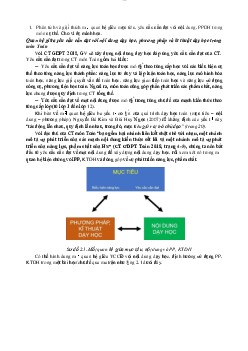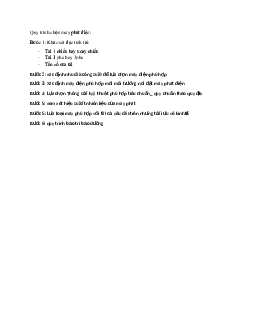

Preview text:
lOMoAR cPSD| 36133485 lOMoAR cPSD| 36133485
TEST ON TRANSLATION 2 (1)
Question 1: Translate the following text into English
Một việc vô cùng quan trọng khi thực hiện đổi mới khi thực hiện dạy trực tuyến là đổi
mới việc đánh giá học sinh.
Thời điểm hiện nay dịch bệnh Covid-19 diễn biến phức tạp, khó lường. Điều này đặt ra
thách thức rất lớn đối với ngành giáo dục, toàn ngành phải đổi mới. Tuy nhiên đây cũng
là thời cơ để ngành giáo dục thay đổi, ứng dụng công nghệ số trong giáo dục.
Bên hành lang Quốc hội trong kỳ họp vừa qua, Bộ trưởng Bộ Giáo dục và Đào tạo
Nguyễn Kim Sơn đã có cuộc trao đổi với báo chí về vấn đề này.
Bộ trưởng cho biết: “…Chúng tôi đã tính đến những biện pháp củng cố kiến thức cho học
sinh khi các cháu được quay trở lại trường học tập, bồi đắp thêm những thiếu hụt về kiến
thức do thời gian học trực tuyến khó có điều kiện triển khai. Đặc biệt, bậc tiểu học cũng
như các chuyên ngành đào tạo khác cần phải được thực hành, cần trải nghiệm thực tiễn, cần có sự củng cố...
Chúng tôi cũng đã tính đến việc gia tăng nguồn học liệu hỗ trợ và điều chỉnh phương
pháp dạy và học để làm sao trong thời gian học trực tuyến học sinh vẫn có thể tiếp thu được tốt nhất.
Chúng tôi coi đại dịch lần này là một cơ hội để ngành giáo dục đào tạo chuyển đổi số
trong toàn ngành từ việc đổi mới phương pháp đến tăng cường học liệu, trang bị cơ sở hạ
tầng kỹ thuật, các điều kiện...
Tôi nghĩ đại dịch COVID-19 đặt ra những khó khăn, thách thức, nhưng chúng tôi coi đây
cũng là cơ hội để có thể đổi mới theo hướng chuyển đổi số.”
Phát biểu của Bộ trưởng Bộ Giáo dục và Đào tạo đã thể hiện quyết tâm của người đứng
đầu ngành giáo dục, là biến thách thức thành cơ hội, quyết tâm dạy trực tuyến, quyết tâm
áp dụng công nghệ số vào giáo dục để học sinh không bị thiếu hụt kiến thức, để học sinh
trở thành người mạnh dạn, tự tin và bắt kịp sự thay đổi công nghệ, nắm bắt và ứng dụng công nghệ.
Giai đoạn này không thể chờ đợi mãi việc hết dịch bệnh, tạm dừng đến trường nhưng
không dừng học là việc làm cần thiết, học sinh nghỉ học dài ngày mất kiến thức, chương
trình không thể hoàn thành, không thể kết thúc năm học, không thể hoàn thành mục tiêu
kép là vừa hoàn thành chương trình vừa phòng, chống dịch. lOMoAR cPSD| 36133485
Question 2: Translate the following text into Vietnamese
Online shopping may not be as green as you think. Here's how online shopping can have
a surprisingly large carbon footprint.
In the past few decades, the way we shop has changed dramatically. We used to buy our
goods in traditional shops, on the high street or in department stores. Now, customers are
increasingly buying online, where they can order whatever they want directly to their
door with the click of a mouse. One in seven sales are now made online and studies
suggest that by 2021, global online retail will reach an enormous US$4.8 trillion. As
companies race to improve their internet shopping experience, the trend towards
shopping online is predicted to continue.
But what is the impact of all this online shopping on the environment? You might think
that online shopping is greener than in-store shopping. After all, an online store does not
use the electricity that a traditional store might use and it doesn't require the customer to
drive anywhere. Items are often delivered to several homes at once, so you would think
the carbon savings must be significant. Take the typical home delivery round in the UK,
for example. Supermarket drivers often do 120 deliveries on an 80-kilometre round,
producing 20 kilograms of CO2 in total. In contrast, a 21-kilometre drive to the store and
back for one household would generate 24 times more CO2!
However, the reality is slightly more complex than that. Many home deliveries fail the
first time and the driver has to make a second or third attempt to deliver the purchase.
Customers who choose speedy delivery or those who buy single items from different
places also contribute towards increasing the carbon footprint.
The carbon footprint also goes up if the customer chooses to return the item. A study in
Germany showed that as many as one in three online purchases are returned. According
to another study, merchandise worth nearly US$326 million is returned each year in the
USA. Two billion kilograms of this ends up in landfill, leading to 13 tonnes of CO2 being released.
Clothing is one product that has high return rates. Unlike in a walk-in store, the online
shopper can't try things on before buying. So, companies offer free returns to make it
easier for shoppers to purchase the same item of clothing in different sizes and colours.
Customers try them at home, keep one and return the rest of them. However, when
clothes are returned, they are not always cleaned and put back for sale. This is because
many companies have found it cheaper to simply throw away the returned items than to
pay someone to sort the damaged goods from the unwanted ones. In these cases, the
returned clothes, which might be in perfect condition, end up in landfills or burnt.

